I think I can get all this in one part. To be quite honest, this convention didn’t match the buildup.
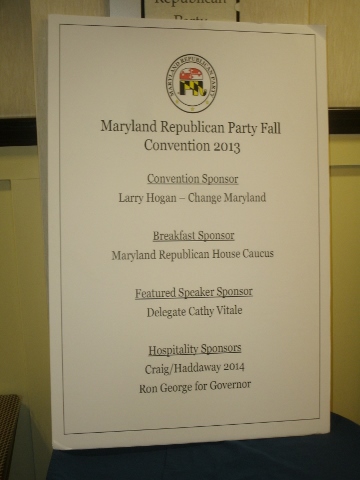
It was sort of strange. I noted earlier in the week that the whole Lollar controversy in the blogosphere overshadowed the months-long debate over the open primary question, and then the prospect of a Larry Hogan gubernatorial announcement upstaged several other events.
These were the scenes around the main ballroom on Friday night after arrival.
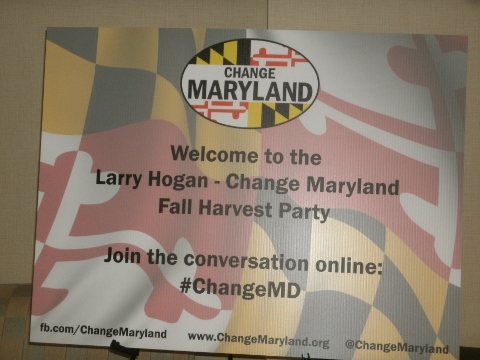
There was no doubt that they were proud of their achievements.

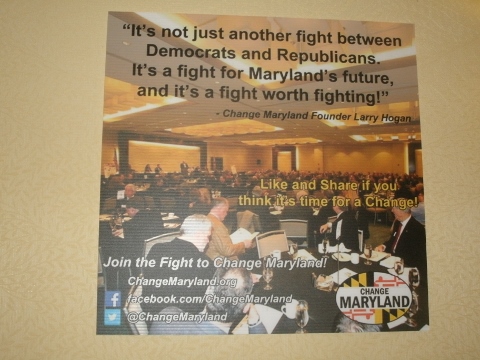
And something tells me that most of these stickers were gone by the end of the night.
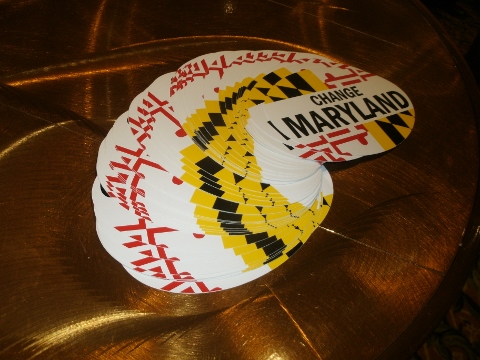
The Change Maryland party even had a live band, called the Great Escape Band. I noted on Facebook that may be something subliminal if Larry doesn’t win.

Aside from one song they sort of butchered up in my line of thinking, the band was really pretty good. They also reinforced my belief that there’s not a band which doesn’t know ‘Mustang Sally.’ Although he actually didn’t write the song Wilson Pickett must be proud, wherever he is.
But when they took their break, the real rock star came into the room.
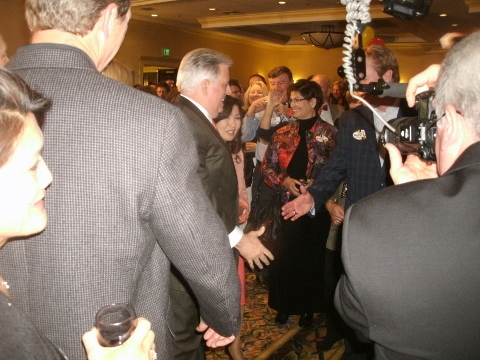
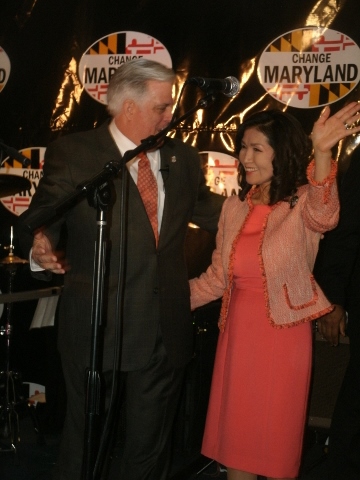
What I have found interesting in looking back and listening again to what Larry said is that my interpretation is much different than what Larry presented to other outlets.
This, which I transcribed from the remarks he presented, is part of what Larry Hogan said last night:
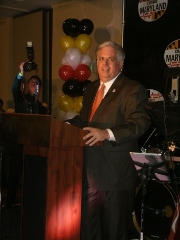
Now everyone who knows me knows that I love this state, I hate to let people down, and that I’ve never walked away from a tough fight.
I’m not a professional politician – I’m just a businessman – but I don’t think that you need to be campaigning all throughout 2013 for an election that takes place at the end of 2014. But, you know, we are getting pretty close to the end of the year.
I promised my wife and family that I would spend a little quality time with them over the holidays, and I’m looking forward to that.
And as you may know I founded and run a group of companies that has brought hundreds of businesses and thousands of jobs to Maryland, and I promised the employees and my colleagues that I would stay at the helm and continue to work hard with them to try to have a strong finish to the calendar year.
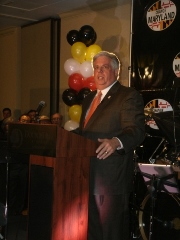
So there won’t be a formal announcement or an official launch until January, but tonight – tonight I wanted to be very clear about our intentions.
I happen to believe very strongly that the people of Maryland simply cannot afford another four years of O’Malley/Brown/Gansler tax and spend policies.
Hogan went on to say, “This isn’t a fight between right and left, it’s a fight between right and wrong.
I honestly believe people went in there expecting Larry to make the formal announcement last night, so once he made his remarks a good percentage of the people left his party.
Of course, Hogan’s wasn’t the only party. Before I stopped by the Change Maryland event, I dropped in to Ron George’s suite which featured this.

I had one other photo which, alas, didn’t come out. Ron actually had a pretty lively thing going early on.
Just downstairs from Ron was David Craig’s suite. The candidate wasn’t there because he was at the RGA meeting in Arizona, but David had a lovely second-in-command to take his place.
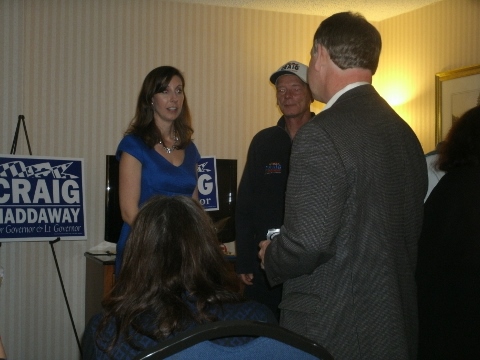
LG hopeful Jeannie Haddaway-Riccio held down the fort. It’s worth noting they had pretty good traffic.
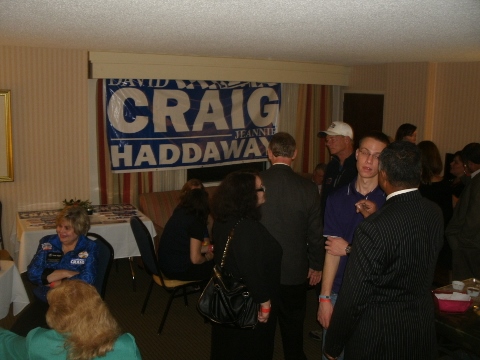
They also have a slew of printed material. I suppose you can cut out the Craig part if you really share the sentiment.
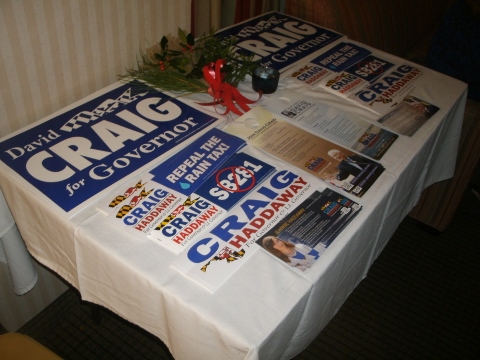
Instead of a suite, fellow candidate Charles Lollar (who was also in Arizona at the RGA) had a lobby table.
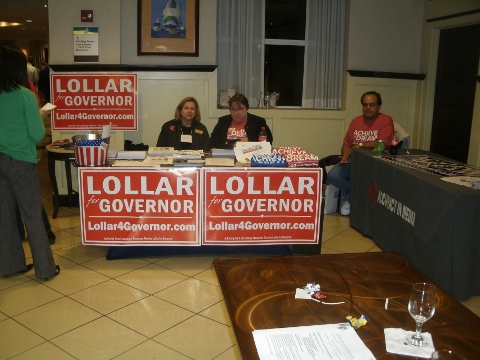
On the table, among the other handouts, was a letter explaining his absence, which read in part:
Unfortunately, this means I will miss the opportunity on Friday evening to meet with you, answer your questions, and tour the hospitality suites, but I look forward to joining everyone on Saturday to share my plans for returning prosperity to Maryland.
One place Charles may have found himself welcome was the Maryland Liberty PAC suite, which was all by itself on the other end of the building. Despite that, they had a lively group.
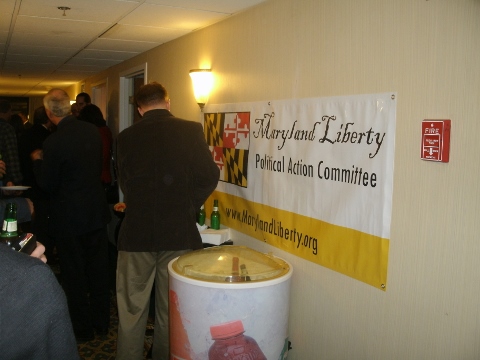
Alas, I think I missed this presentation.
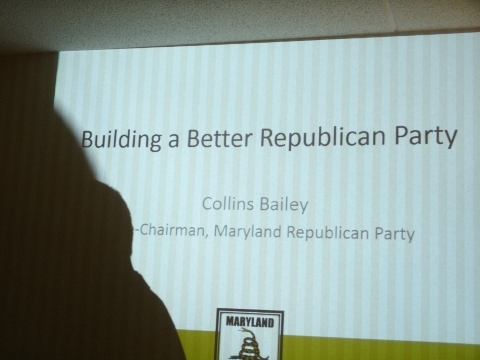
The other suites were county suites from Montgomery and Anne Arundel counties. This photo was of the Anne Arundel suite, which by the way had the best food.
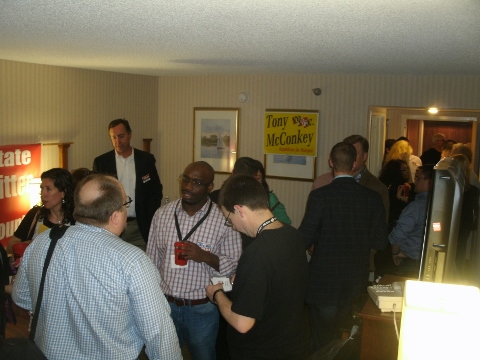
But it seemed like a lot of the air was sucked out of the celebrations early, with most of the parties finished before the clock struck 12. That’s when I took to Facebook and wrote:
So my thoughts on day 1 as I head to bed:
I’m sure I’m not the only one scratching my head over Larry Hogan and his decision to wait to announce his intentions until January. The chatter around the convention seemed, well, less than positive. He had 1,000 supporters in a festive mood and plenty of press only to cite family and business as reason to wait.
There were a number of good parties about, though, and I renewed acquaintances with a number of friends and fans. But pardon me if tomorrow seems a little less exciting.
I think I’ll have some more thoughts on all this tomorrow, but allow me to move on. They probably won’t be in line with the thoughts of these gentlemen: from left to right, Jeff Quinton of The Quinton Report and Greg Kline, Mark Newgent, and Andrew Langer of the Red Maryland Network.
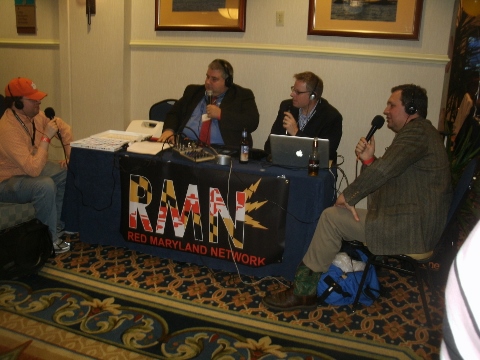
And no, I was not on their show last night. Wasn’t sought out and didn’t seek them out – gave some others a chance.
This is what I saw looking out the window this morning.

So when I woke up, I was at least expecting to deal with this lengthy issue regarding open primaries – finally, a chance to decide. Wrong!
I suppose I should back up and point out that I did not cover the Friday evening Executive Committee meeting as I usually do. There were a couple reasons for this, but the primary one is that I was the escort for a good friend of mine who was the lucky recipient of my second Change Maryland ticket. But had I done so I may have found out that open primaries wouldn’t be discussed. Nor did I do breakfast this time, because the speaker didn’t appeal to me.
So the first (and only) Saturday event I attended was our combination lunch and session.
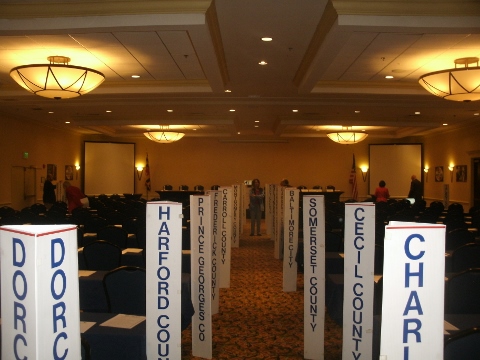
Let me say that I thought having the lunch and session as we did was a splendid idea, with the key reasons being we didn’t have to get settled in after lunch in a different venue and the fact we could sit at tables – no more balancing my note pad on my lap.
First we heard welcoming remarks by Anne Arundel County Executive Laura Neuman.
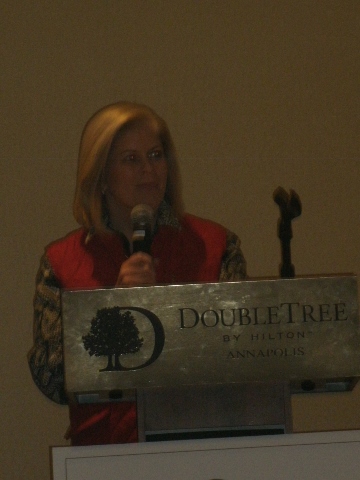
Yes, the photo is dark. But Laura had an intriguing story of being an MBA without being a high school graduate. Her remarks reflected a philosophy which said “over and over, if I worked hard, opportunity would be available to me.”
“My story could only happen in this country,” she added. “That’s why I’m a Republican.” She expressed the belief that hard work should equal opportunity.
Our luncheon speakers both came from the RNC.
Kristal Quarker-Hartsfield is the director of African-American Initiatives whose family “has been Republican since Reconstruction.” Her task was to spread the Republican message to areas not typically reached by the party, including black churches, historically black colleges and universities, and so forth. She added that Reince Priebus was “serious about going into these communities and doing things the right way.”
Meanwhile, Stephen Fong noted there’s “a good mix of people” here, and talked about the GOP’s renewed emphasis on minority communities. He made the case that many blacks would “consider” voting Republican if we were “just showing up.”
There was a buzz about the next speaker as well.
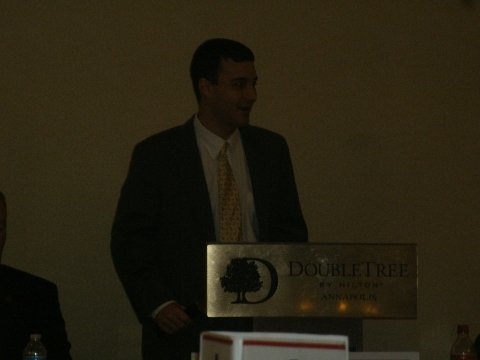
Described by Chair Diana Waterman as the future of the party, Annapolis Mayor-elect Mike Pantelides briefly outlined some of his secrets to success, particularly in social media. (The Twitter debate seems like a good way to promote brevity of remarks.)
With that out of the way, we rolled through some convention business so routine I snapped this on the Allegany County sign.

I guess the one interesting part was the complaint that the minutes didn’t reflect a resolution which was on the spring agenda but not brought up – the Tari Moore resolution tabled a year ago. But parliamentary procedure showed it was dead once the gavel fell in April.
So we moved on to State Senator David Brinkley’s report on the Senate, where we have a “tremendous field of candidates.” He made sure to mention that if Anthony Brown thought he’d have a coronation, he should have a cup of coffee with Kathleen Kennedy Townsend.
Brinkley bemoaned the economic state of the state, making the case that job creators are “voting with their feet” and “anyplace south of the Potomac is friendlier (to business) than Maryland.” If we want more manufacturing jobs, Brinkley added, “right-to-work has to be one of the conversations.”
Overall, David believed that “even the Democrats are disgusted with the games and gamesmanship.” All we need are candidates who are conversant with the issues.
On the House side, Delegate Kathy Szeliga was kind enough to pass out her report, which highlighted many of the measures to be considered in next year’s session. It’s a list which includes tax cuts, a repeal of the “rain tax” and Common Core, protecting charter schools and creating a voucher system, and modifications to the gun bill.
Moving into the Chair’s Report, Diana Waterman exhorted us to “take advantage of all the opportunities our liberal Democrats gave us.” She also pushed an initiative called the Old Line Club, which was a monthly fundraising of $8 or more a month, automatically deducted.
But I found the Executive Director’s Report from Joe Cluster made me sit up and take notice: county-by-county goals. Even the Republican strongholds of Carroll and Garrett counties had marching orders: hold what you have and help other counties out.
Nicolee Ambrose, in her National Committeewoman’s Report, touted the successes of the Super Saturday program in Annapolis and Frederick. It also served as a good test market for issue advocacy, and next year the program will be expanded and divided into pre-primary and post-primary positions.
She also related the success of 3-part fundraisers like the Allen West event in Prince George’s County as a model for others to follow.
On a national scale, Nicolee spoke on IT improvements the party was undertaking as well as the winter RNC meeting in Virginia.
As is often the case, National Committeeman Louis Pope was optimistic: “We’re going to have a phenomenal year in 2014,” he predicted. He shared good news on the financial front and on how the party was working on regaining its technological advantage. Moreover, Obama’s “Teflon-coated presidency is coming to an end,” said Louis.
Pope also spoke on Maryland, calling the state one with a “very angry electorate” and “very energized (GOP) base.”
Finally we made it to resolutions. Two of them made it out of committee and two didn’t.
The ones which were presented to the floor came from John Fiastro, Jr. and Dave Myers.
You could call Fiastro’s resolution the Don Dwyer resolution, since it seemed tailored with his situation in mind. But Delegate Michael Smigiel, who was carrying a proxy, spoke up and called it “too broad.” An amendment to allow for acts of civil disobedience to address Smigiel’s concerns failed on a voice vote when Smigiel noted “there’s not enough lipstick to put on this pig.”
Once the question was called, the Fiastro motion failed by a large margin, over 75 percent voting against.
The other resolution was one which called on the party to stop sending “mixed messages” and integrate the pro-liberty community. It lost on a voice vote, even after the “mixed message” portion was excised. But Diana Waterman promised to create an advisory committee to hear the diverse portions of the party after the first of the year. So we’ll see.
Certainly the Maryland Liberty PAC and other groups will be watching.
There was an attempt to get one other resolution to the floor concerning the Frederick robocall, which had some support. But more people wanted to adjourn, which was the motion presented by Nick Panuzio of Talbot County. He’s good at that. (Update: I’m told by Denise Lovelady of Talbot that it actually was Josh Horner who motioned to adjourn, but I heard the motion credited to Nick by the Chair. So let’s say Talbot County is good at that.)

Upon driving home, though, the four of us who traveled together saw perhaps the prettiest sunset we’d seen in quite some time, so I’m going to take it as a divine sign we did something right even if it wasn’t expected.


























